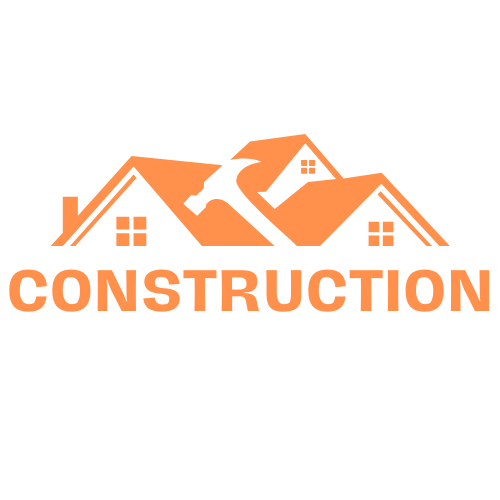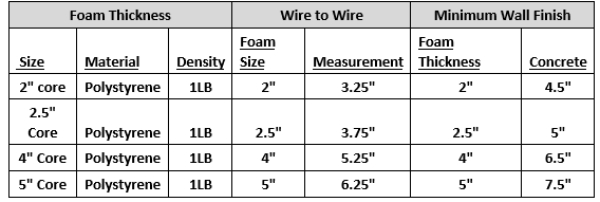FAQ's
What is the SCIP Panel? How is it made? What is it made of?
The SCIP (3D Structural) Panel is a prefabricated panel made in America, consisting of 100% recycled materials that easily meets LEED Platinum requirements and consisting of a super-insulated core of rigid expanded polystyrene sandwiched between two-engineered sheets of eleven-gauge steel welded wire fabric mesh. To complete the panel formation process a nine-gauge galvanized steel truss wire is pierced completely through the polystyrene core at offset angles for superior strength and welded to each of the outer layer sheets of eleven-gauge steel welded wire fabric mesh. When Portland Cement is applied, by any method, the panel becomes a structural load bearing insulated wall system. Once these three elements are joined by EVG’s state of the art manufacturing equipment, you end up with a THREE-DIMENSIONAL lightweight panel that due to its characteristics makes it one of the strongest building materials you can find.
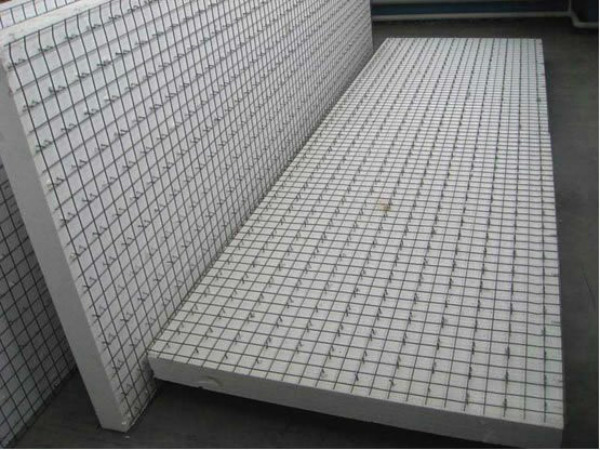
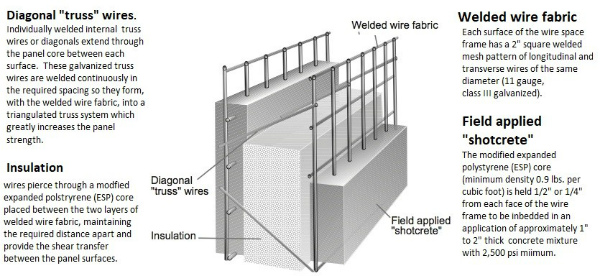
How is the SCIP Panel used?
The SCIP (3D Structural) Panel is used for numerous building applications. It may be used in place of wood framed walls, metal-framed walls, and masonry block walls or in place of pre-cast panels. The panels may also be used for floor systems, ceilings and to provide a roof structure. They are an excellent product for building privacy walls around the home or building structure. SCIP Panels are being used by many landscape companies in place of masonry block. With handsome good looks and great flexibility, the SCIP Panels can be used in conjunction with all of the building trades above.
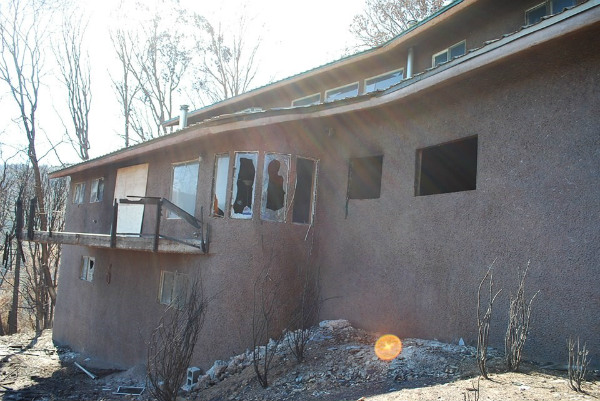
All around his neighbor’s houses burned to the ground but missing a few windows this SCIP (3D Structural) Panel home survived.
The panels are also an ideal building product for structures in dry adverse climates where fire is always a constant threat – areas which are heavily forested, high grass and brush, and areas in Southern California during Santa Ana Wind Conditions. A structure built with the SCIP Panel is non-combustible and has a minimum 1.5-hour fire rating – and a higher rating can easily be attained. Full test report from certified engineering firm are available upon request along with photos.
How do SCIP Panels hold up under adverse conditions of Hurricanes, Tornadoes, Earthquakes and Fires?
The SCIP (3D Structural) Panel has excelled in rigorous test by Mother Nature. For the last many years, homes have been constructed around the world with the SCIP Panel System including nearby the U.S., Caribbean and Gulf areas of Mexico. The homes were built to withstand hurricane force winds. In Laboratory testing, the panels have been tested and will withstand wind loads of 226 miles per hour.
In the southwestern area of the United States, a two-story 3D Structural Panel research complex jointly funded by the National Science Foundation, Southern California Edison, Inc., and the University of California withstood California’s worst earthquake in forty years. It was struck twice a (6.5) and (6.9) Richter Scale. According to Dr. Philippe Cohen who resides at the site in the Mojave Desert, the area at one point was subjected to a continuous shake lasting over a full minute. The structure went through the quakes with zero structural effects. Complete (Earthquake) structural testing report from certified engineering firm are available on the above upon request.
What code's do SCIP Panels conform with?
The SCIP (3D Structural) Panel meets the CABO one and two-story family dwelling codes (Compliance Report No. NER-454, 1/01/1993) which satisfies all SBCCI, ICBO and BOCA requirements for standard buildings. The 3D Structural Panel also has:
-
- HUD compliance covered under SEB# 1120
- CABO-Council of American Building Officials ICBO-International Conference Building Officials –
- SBCCI-Southern Building Code
- Congress International, Inc.
- BOCA-Building Officials and Code Administrators
- HUD-Housing Urban Development (SEB# 1120)
- NES – National Evaluation Service, Inc. (NER-454)
- Miami-Dade County Building Code – Compliance Office American Society for Testing and Materials
- American National Standards Institute
Copies of the above reports available upon request
How do SCIP Panels compare in cost to other building systems?
The Panels account for just a fraction of your structure’s cost with the final cost dependent upon the design and finish of your project. Every structure is unique like a fingerprint; no two are alike. Our product is not price competitive with (2×4) stick framing but is competitive with (2×6) stick framing, metal stud framing and is more competitive than block. Keep in mind the SCIP (3D Structural) Panel is extremely versatile and can be used with any of the above systems. For return on investment, SCIP (3D Structural) Panels readily beat stick framing as well as most other building systems. The dollars you spend on our panels can be made up very quickly in energy savings alone. Over the life of the structure, the savings are quite staggering.
What choices of SCIP Panel core density and steel mesh styles are available?
Dimensions of the SCIP panels are manufactured from a starting width of (4′) x (8′) length. The panels can be prefabricated up to (40′ in length) in (8″ increments). Truss wire gauges available are 11, 12.5 and 14. Polystyrene Core Outer Layer Wire Thickness Mesh to Mesh 1.5″, 2.5″, 2.0″. 3.0″ ,2.5″, 3.5″, 3.0″, 4.0″, 3.5″, 4.5″, 4.0″, 5.0″, 4.5″, 5.5″, 5.0″, 6.0″. Please request a price list and information on custom made panels to meet special requirements you may have on future projects.
What are the load bearing capabilities of SCIP Panels?
A typical 3D Structural Panel with 2.5″ polystyrene core using eleven-gauge wire, 8′ in height has been tested at a structural load of over 78,000 lbs. The typical wood frame and metal frame wall cannot compare. Full load bearing chart available upon request.
Here is a list of attractive benefits of the SCIP Panel System
- Fast, High Quality Construction Time saved. 50% faster than standard construction – Speedy occupancy – Saves money on construction loan dollars – Enhanced resale and marketability value – Reduces the need for heavy equipment on job – Fewer trades on job site.
- Strength, Durability, Greater Structural Integrity, Virtually maintenance-free wall system. Saves on long term replacement cost of structure Polystyrene panel or concrete – Will not decay – Monolithic design for superior strength.
- Safety, Security, Excellent performance in seismic zones (Earthquake Resistance). Non-combustible structure – Savings of 18% to 30% on fire insurance – Excellent high wind protection-up to 225mph – Insect Termite Rodent Resistant – Mold, mildew, and fungi resistant.
- Pro-Environment – Energy Efficient – Maximum Conservation of forestry products. Structure durability offers value for generations and saves many Earth resources – Dramatically reduces consumption of fossil fuels.
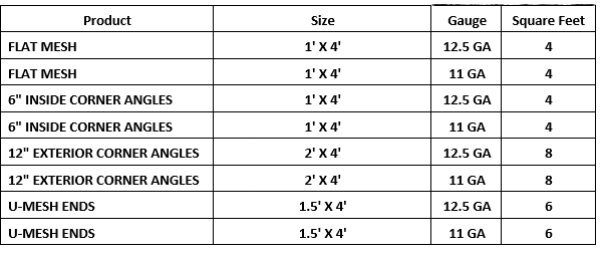
- Electrical and plumbing is through the interior side of the SCIP (3D Structural) Panel, so there are fewer wall penetrations, which keeps thermal loss at a minimum plus the incorporation of minimum (3″) density of shotcrete and variable thickness of polystyrene ranging from 2″ through 5″ offers an excellent thermal barrier. And there are no wood studs to transfer or conduct heat or cold through the exterior walls. All this together reduces the size and cost of HVAC systems and Saves 50% to 80% of utility costs on heating and cooling the structure.
- Quality, Comfort, Design Flexibility. Virtually eliminate outdoor noises. Reduce drafts and wide temperature fluctuations – Enjoy air quality virtually free of dust, pollen and allergens with use of an air exchanger – Create an acoustical environment for full advantage of sophisticated sound systems and home theaters.

What about thermal value heat loss?
The SCIP (3D Structural) Panel System has been designed with maximum environmental comfort in mind. A wood structure simply cannot compare to the comfort level available with the outstanding energy savings created by using the SCIP Panel System. SCIP Panels will keep you cooler in the summer and warmer in the winter. The modified expanded polystyrene core meets all VA, FHA and HUD thermal requirements.
What is the insulation (R) Value factors for the SCIP Panel?
R-Value is a rating of the material resistance to thermal penetration. The higher the number the better the protection value. R-Values change with the different thickness and density of the polystyrene panel core, various thickness of shotcrete applied to the interior and exterior as well as fluctuation of ambient temperatures. Statistics shown below shows the minimum R-Value Ratings you can expect using the SCIP (3D Structural) Panel. A 2lb. Polystyrene Core will provide an additional 10-12% R-Rating. A Polyisocyanurate, also referred to as PIR, polyiso, or ISO core is optional when panels are ordered.
2.5″ 1.0 LB Polystyrene Core R-Value = 11.00 2.5″ 1.0 LB Polyisocyanurate Core-R-Value = 21.00 4.0″ 1.0 LB Polystyrene Core R-Value = 18.00 4.0″ 1.0 LB Polyisocyanurate Core-R-Value = 33.00 5.0″ 1.0 LB Polystyrene Core R-Value = 23.00 5.0″ 1.0 LB Polyisocyanurate Core-R-Value = 41.00 Polyisocyanurate is a special-order foam core used primarily for refrigeration purposes or specialty items. R-Values stated is within FTC guidelines.
What is the (S.T.C.) Sound Transmission Coefficient?
The S.T.C. (Sound Transfer Coefficient) attenuation is excellent. The double shell configuration of the concrete plus polystyrene plus concrete sandwich minimizes sound transmissions. Typical S.T.C. expected is as follows:
3″ Concrete (1.5″ each side) = [0.1304 x 38] + 43.48 [4.9552] + 43.48 = S.T.C of 48.4352
4″ Concrete (2.0″ each side) = [0.1304 x 50] + 43.48 [6.52] + 50.00 = S.T.C. of 50.0000
Calculated from the PCI Pre-cast Manual.
Note: We are currently working on a new polystyrene panel, which will have an integrated air pocket that will greatly improve this rating.
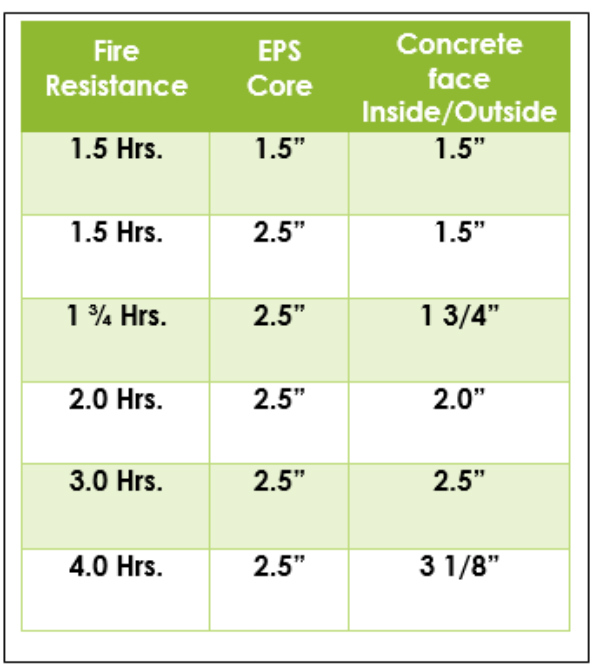
What is the fire rating of a SCIP Panel?
SCIP (3D Structural) Panels have the following fire-resistance ratings – See chart. (Ratings are valid for fire exposure from either side)
The insulation core Type I polystyrene foam demonstrated a flame-spread index of 25 or less and a smoke developed rating of 450 or less when tested in accordance with ASTM-E84.
The modified polystyrene core does not contain ozone-damaging chlorofluorocarbons (CFC’s) in the manufacturing process or products.
The Polystyrene core will not burn. The fire rating increases with greater quantities of cement applied to each side.
Is the polystyrene waterproof? Is the foam waterproof?
The polystyrene and the foam are the same. The polystyrene core is water-resistant. The ASTM test proved maximum water absorption of (2.5%) for (1lb density). while EPS (Expanded polystyrene) is an innovative building material that lends to the design and structural integrity of many building projects, it is an inert, organic material. It provides no nutritive value to plants, animals, or microorganisms which keeps the termites away. It will not rot and is highly resistant to mildew. Aging has no effect upon the performance of the polystyrene. It can withstand the abuse of temperature cycling 180° assuring long term performance. Please refer to fire rating for flame spread information.
What are the wind load capacity of SCIP Panels?
The brief synopsis which follows, is from the test results report dated in 1994 from Dade County, Miami Florida pertaining to the wind load capacity of our panels. Three typical SCIP (3D Structural) Panels 4′ wide and 10′ high with 1-1/2″ of shotcrete on each face were installed vertically, side-by-side, on a concrete slab, several inches in front of a rigid backup wall with space between the panels and the backup wall. The panels were tested per static-wind load test (PA202-94 manner of testing).
Summary: The specimens tested herein were fully tested in accordance with the Dade County Building Code Compliance Office Protocols PA 201-94, PA 202-94, and PA 203-94. No failures occurred to the specimens nor their fastenings nor the anchorage. The products described in this report comply with SFBC Sections 2309 and 2315. The panels tested at 126 lbs per Sq. Ft. pressure, which represents over 225mph-wind factor. Wind load charts are available upon request.
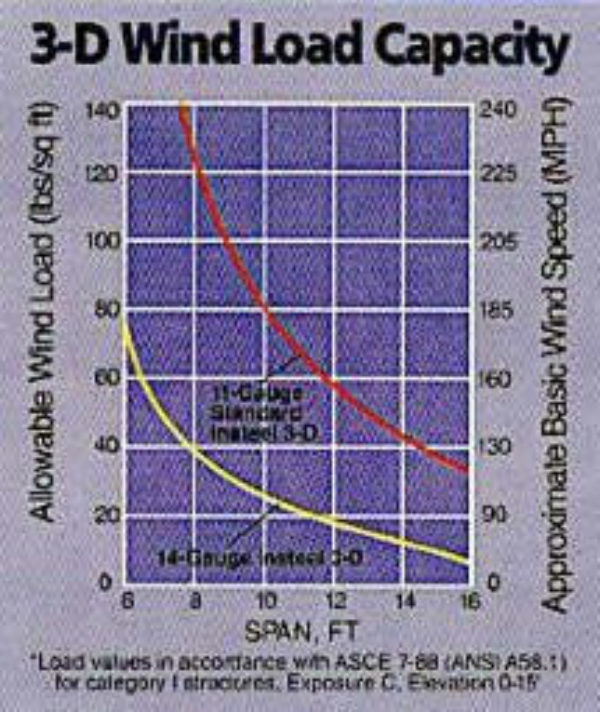
How is the SCIPPanel secured into the slab?
The rebar is embedded within the concrete slab. The panel is placed over the rebar, through the open space between the polystyrene core and the wire mesh. Once set, the rebar is fastened directly to the wire mesh by hand with tie wire. It is critical the rebar be installed in a straight line so the rebar fits easily into the cavity between the polystyrene and the wire mesh. It is important to make sure the rebar is completely exposed so it becomes monolithically enclosed with the shotcrete or cement application. Should the building department or engineer require additional tie downs, the polystyrene core can be removed from the base of the panel. The panel is then set in place over the required tie-down and cemented in place. Another option for placing the rebar in the concrete slab is to drill the concrete slab and pour epoxy in the cavity placing the rebar within its confines. Typically, the spacing of the rebar is (24″) on center.
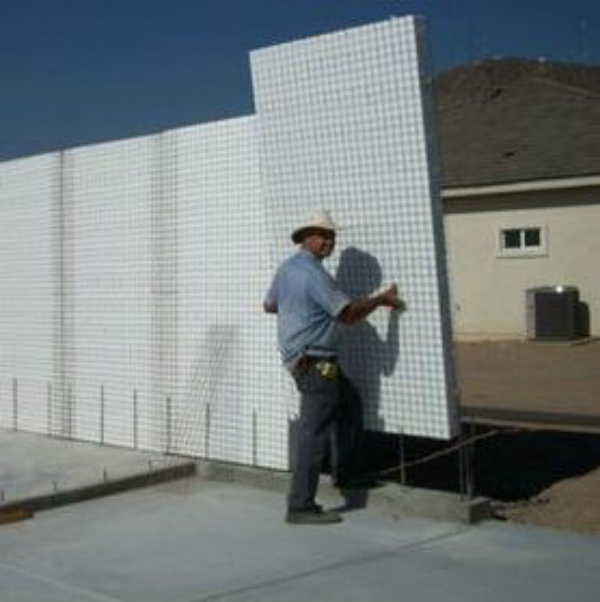
How is a bond beam made with the SCIP Panel?
A bond beam is used to create large openings, or to strengthen large areas of ceiling or to help support roof structures. All bond beams created should be pre-approved by a certified engineering firm. Removing the polystyrene core and installing rebar creates the bond beam. The best method for removing the polystyrene core is a high-pressure water blaster which it takes only a matter of minutes. For further information please see instruction manual.
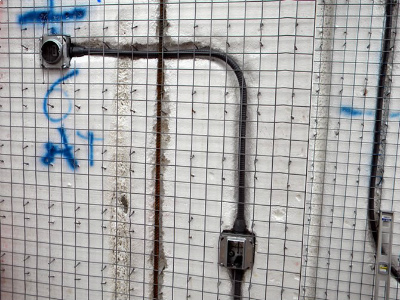
How is the electrical and plumbing installed?
The installation of electrical or plumbing is achieved by removing the polystyrene core to create a cavity into which the electrical conduit or plumbing piping may be installed. The polystyrene is approximately 3/4″ off the wire mesh so that you have a space to install these products. If the opening needs to be greater the polystyrene core can be removed with a small keyhole saw or butane torch. While the polystyrene will not burn it will shrink or melt leaving a cavity. The electrical or plumbing is then installed into the cavity. For further information please see instruction manual.
How are windows and doors installed?
The window and door openings may be cut out with the use of three primary tools – a reciprocating saw, a set of 18″ bolt cutters or pneumatic cutter, and a small hand saw to remove the polystyrene. It is recommended that a caulking sealant compatible with the polystyrene core be used to seal the jamb to the polystyrene core. For residential construction, wood jambs of treated material are then fitted into the openings. The windows and/or doors are then fastened to the treated jambs. For commercial use, pre-finished concrete openings are created. The windows and doors are then installed into the openings, as they would be into a typical masonry block structure. For further information please refer to instruction manual.
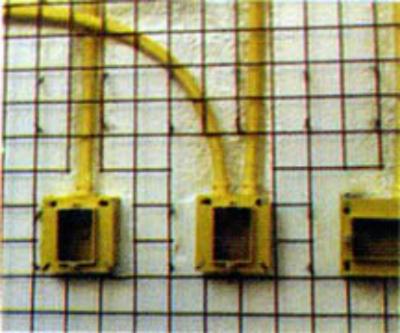
How do you build curved or radius walls with SCIP Panels?
You can build curved or radius walls by cutting the eleven- gauge wires on one side of the panel. This will allow the panel to bend to the desired shape or radius. It is very important not to cut through the heavier nine-gauge truss wire so that wall strength and integrity remain intact.

How are various shotcrete or cements applied to the SCIP Panel?
The shotcrete is applied either by hand or machine application on both sides of the SCIP Panel. This part of the operation is very specialized. We recommend a licensed Gunite or Stucco Contractor or a combination of both Contractors for this part of the operation depending upon the desired finish. For architects with a special finish in mind we would like to mention that the architectural molds or metal trim could be incorporated into your design to achieve the desired finish. A few of the above-mentioned might be fry reglets, point to point reveals, parting screed, or etc. The versatility of numerous types of plaster finishes or stucco finishes will work on interior and/or exterior walls. All the newly created EIFS systems will also work. Additional products you may apply include brick, mini-brick, stone, stone facing, tile or almost any type of finish your imagination can conceive.
